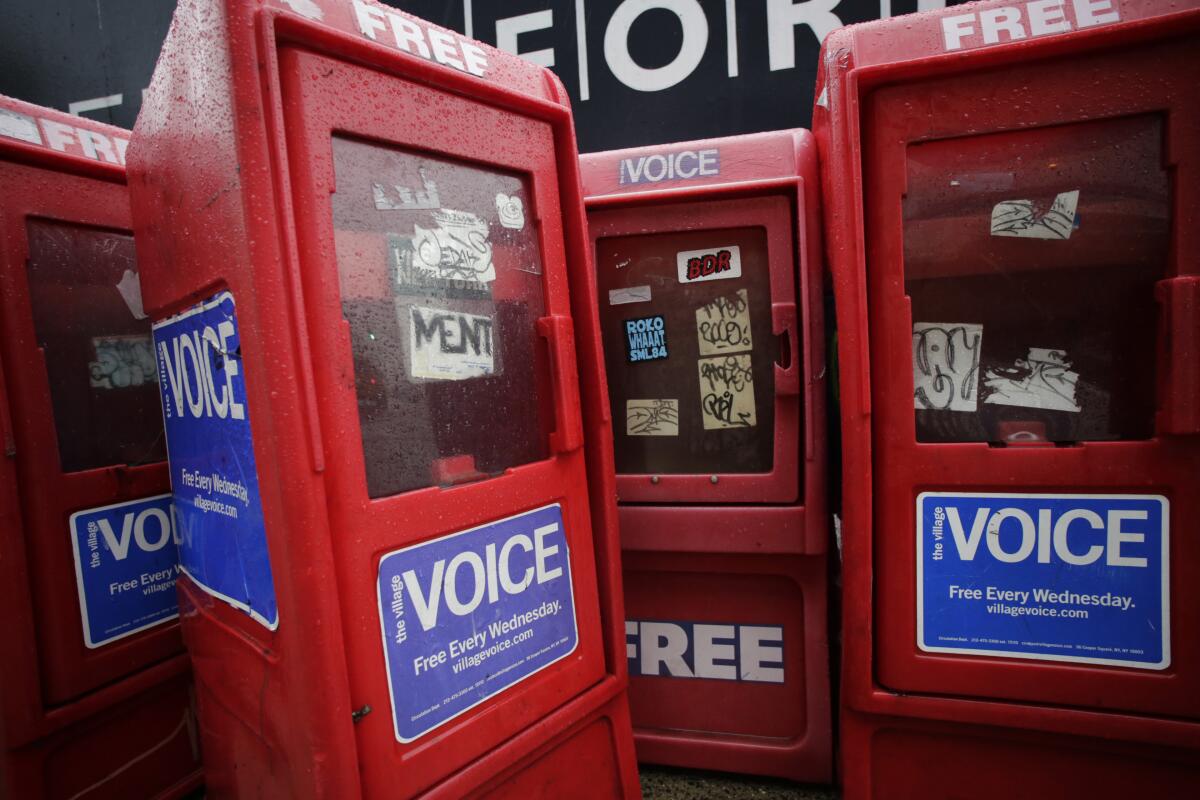Why buy the Village Voice?

When Brian Calle purchased L.A. Weekly, no one saw it coming.
The editor of the Orange County Registerâs opinion section, backed by a group of investors initially kept secret for weeks, seemed like an unlikely buyer for the irreverent, muckraking alt-weekly.
He surprised the media world again in December by purchasing the nationâs most storied alt-weekly, the Village Voice. Through his company Street Media, Calle bought the Voice, which ceased publishing in 2018, for an undisclosed sum from its former owner, Peter Barbey. Calle has hired a former Voice editor to oversee its revival and plans to relaunch the website this spring, eventually publishing a print quarterly as well as podcasts and videos. In an unrelated deal, Calle also acquired the San Francisco neighborhood paper the Marina Times.
Calleâs stint as L.A. Weekly publisher has not been without controversy. There were sweeping layoffs, followed by accusations of a conservative takeover of the historically left-leaning publication, due in part to Calleâs connection to the far-right Claremont Institute and other right-wing organizations. Former staffers and contributors started a boycott movement against the paper. An investor filed a lawsuit accusing Calle and the rest of the ownership group of having âpillagedâ the company, only to settle for undisclosed terms in 2019.
Calle offered to speak with the L.A. Times at length about the deal, though he declined to comment on the financial details of the purchase or the settled suit. The following interview has been edited for clarity and brevity.
So, why buy the Village Voice?
When the Village Voice closed, I was like, âThat shouldnât happen.â If it was different timing for me, we probably would have attempted to save it then. But I was in the middle of learning L.A. Weekly, cleaning up a lot, and there was just no way that I could have taken on something else at that time. It would have been frankly irresponsible.
I was following the number of closures in the industry this year, and it got me thinking as I went to bed at night: Well, what can be done? Weâre going to come out of this pandemic â where were the voices that are going to be needed?
I kept going back in my head to New York, because in many ways New York is Americaâs city. Not taking anything away from L.A., which I think is the purveyor of culture in the country. But I thought, the Village Voice is going to be super important when things start to go back online. Besides its reputation for hard-hitting investigative journalism â which is going to be needed in the aftermath of COVID â people are going to want to go out, whether itâs to concerts or festivals or nightlife or food or art or the theater. The Voice is probably more important than ever. So I just called Peter Barbey.
Did you have a personal connection to the Voice before buying it?
Oh, yeah. I certainly read it. And you know, on trips to New York, I would always pick up the Village Voice. There was always something funny and sassy, like Michael Mustoâs column â my favorite â and then good information about what to do, where to go, what was hip.
Do you have any favorite parts of New York City? Places to go? Restaurants?
I can tell you one of my favorite places, which I donât even know if I should tell you because itâs kind of embarrassing, but one of my favorite restaurants is called La Esquina, which in Spanish means the â you know, I speak Spanish â it means the corner.
Itâs like this hole-in-the-wall taco stand and Mexican restaurant, literally on a corner, but then thereâs also a downstairs speakeasy situation thatâs also a restaurant that serves Mexican food and has a really cool bar. I donât think a trip goes by that I donât go to La Esquina.
And then also, for entertainment thereâs this kind of alternative show, a cabaret theater kind of situation, but very, very alternative, called the Box, which is super crazy and off the wall and just really different. I like to experience everything. So that is a place that Iâve gone to a few times when I was in New York. Itâs just one of those things where I was like, wow, mind blown.
Have you ever lived in New York?
I never lived in New York. My grandmotherâs from New York, God rest her soul. So I grew up in a household with a very, very New Yorker grandmother.
You lived with your grandmother growing up?
For a time, yeah. I grew up poor. Everyone thinks Iâm this super-rich billionaire that had a silver spoon in my mouth and magically went to USC, but no, I grew up super poor. When we werenât living with my grandmother, my mom was on welfare and food stamps for a time, and she ended up working three jobs, and I went to community college, as the first person in my family to go to college, and then transferred to USC, and then because I performed pretty well on the speech and debate team at both Mount SAC [Mt. San Antonio College] and USC I got offered essentially a full ride to grad school at Cal State L.A.
Did you spend your whole childhood in Southern California?
I was born in Whittier, and then we moved to Chino, out in the Inland Empire. If you read stuff about me online, it would be very hard to piece that together. I read a story saying I was a white heterosexual Trump supporter from Orange County â Iâm half-white, Iâm not heterosexual, I didnât support Trump and I wasnât born in Orange County.
Youâre not a Trump supporter but you were a conservative commentator at the Register, and worked at the Claremont Institute. Did you grow up with those politics?
No, my grandfather was a union Democrat and worked in a bakery. My grandmother was a Democrat. My mother was a Democrat. I was an independent and then for a brief period of a few years turned to Republican and then I was like, I canât do this either. So I am now âdecline to state,â and I have been for many years.
And itâs so funny because, people are always like, âOh, the Claremont Institute!â I was 26 years old and it was a 10-month stint. At that time in my intellectual progression I was like, âI think I can fix the Republican Party.â If the Republican Party was conservative on taxation and economics but was progressive on social issues, then it would be in my mind a better situation. An opportunity came up with the think tank, and I thought, maybe I can move the needle in that direction. I realized after 10 months that I wasnât able to do that.
Do you think your personal politics are in conflict with running historically left-leaning alt-weeklies?
No, not at all. If I donât agree with a piece of content, as long as itâs well written and thoughtful and not name-calling, then I just think, âOh, thatâs cool, I learned something.â For me, itâs never been about steering the content in a particular way.
When did you first make that call to talk about buying the Voice?
I got in touch with Barbey during the summer â I have a photographic memory, and Iâm pretty sure I was in the car with my ex-boyfriend in June when we connected.
Barbey told the New York Times that other people had approached him, but he thought you had the âbest philosophy.â What is that philosophy?
I donât want to speak for him, but a lot of people had come in with the idea to turn the Voice into something else, like a digital marketing company. I think he didnât want to do that because he viewed himself as a steward.
I told him that my philosophy was a brick-by-brick philosophy. Iâve seen firsthand people come in with a bunch of sizzle and bang and spend a bunch of money and invest in this and spend money on that and hire all those people, and then a year later, they go bankrupt.
My attitude is that you pay for the first brick, and then when you get revenue from that, you pay for the next brick. One of the things that I think weâve been successful in doing is building out tangential revenue streams to support the journalism work.
How is L.A. Weekly doing financially since you took control?
The proof is in the pudding. We were never in a situation where we were going to close this year. Obviously itâs been a super challenging and tough year for us â and I have very little ability to predict what next year is going to be like. But with that said, weâre not in like a, âOh, wow. Amazingâ place, but weâre in a good place.
You mentioned tangential revenue streams. What have you been trying out?
Weâve started to leverage our expertise on the content side of things. We create content for a lot of our clients, whether itâs video or audio or written content that they use on their own platforms.
We also have a digital agency where we do all sorts of stuff: media buying, Facebook and Google ad management, social management, stuff like that for clients. We also have an influencer program â Iâm reluctant to call it an influencer agency â but we do manage influencer marketing, and have a network of influencers with whom we work for clients.
You said other people were approaching Barbey about turning the Voice into a digital agency. What youâre describing sounds digital agency-adjacent. Whatâs the distinction?
The goal of the tangential businesses is to serve the journalism work, which is becoming increasingly hard to finance through traditional revenue models or ads. Some folks are buying publications just to make them a digital agency or use their sites for those purposes, but our purpose is to continue the journalism.
I couldnât imagine a situation where we just had the revenue side of the business. Thatâs not what I signed up for. If that was the case, I would have just gone into another industry where I could make money, instead of trying to be a part of the solution in a really, really difficult industry.
L.A. Weekly and the Village Voice were muckraking papers for most of their history. Do you want to revive that tradition?
Iâm very interested in reviving that. As you know, the first thing that a lot of media companies cut when theyâre making cuts is investigative journalism. Itâs expensive but arguably the most important thing that we do as an industry, so the question of how we create enough sustainable revenue to afford that occupies a lot of space in my head.
Why havenât you already invested in investigative journalism at L.A. Weekly?
Again, thatâs a brick-by-brick approach. We have done some investigative journalism over the last three years, but I think that weâve just gotten in the groove of doing daily news coverage now.
Whatâs the idea with the print quarterly?
The idea behind the quarterly, frankly, is that itâs safe from an economic perspective. Getting a physical print product out is an incredibly expensive process, but I can make a quarterly publication work from a quality-of-journalism perspective, a conservation-of-resources perspective, but also a revenue perspective. If demand from both readership and advertisers is greater than that, then weâll just expand it.
L.A. Weekly under your tenure has been criticized for leaning heavily on sponsored content. Many publications â including the L.A. Times â run sponsored content, but thereâs a piece that went up last month on the Weekly, for instance, that amounts to a press release about a commander of the Peshmerga Forces in Iraqâs Kurdistan region, promoting his social media accounts. How does that end up on L.A. Weekly?
We have standards â thereâs certain stuff that obviously we wonât take, anything thatâs illegal or illicit or libel or slanderous. People hit up the sales reps and often they want press, and we canât and wouldnât sell press, but we can sell sponsored content, where they can tell their own story in their own words.
It has to be clearly labeled as sponsored, it canât be anything illegal, and the links we provide for the story are no-follow links, so itâs all done aboveboard.
Occasionally if thereâs something on the fringes, my team will call me or email me and say, âHey, would we be OK taking this?â In those instances, if they have to ask, the answer is probably no.
You spoke earlier about the issue of declining trust in the news these days. Do you think that running sponsored content can undermine that trust?
Not when you have it labeled, like we do. We have it labeled more aggressively than I think any outlet that Iâve seen. And I think that when you talk to our editorial team, they would say itâs a necessary evil. The industry has accepted it as a necessary evil. It is a good tool and resource for advertisers, and Iâm not going to criticize people who are spending money to support journalism.
Youâve now bought two of the countryâs best-known alt-weeklies â a category thatâs been struggling or, in the case of the Village Voice, dead, for years. What do you think the alt-weekly has to offer?
One thing we often forget in the industry is that the average consumer out in the marketplace, and particularly young consumers, they donât know what an alt-weekly is. They just know that this is a trusted and vaunted media brand, right? This is a journalism institution.
And donât take my word for it. Iâm teaching two classes at Chapman [College] right now, and if you ask one of my students what the Village Voice is or what the L.A. Weekly is, none of them will say itâs an alternative weekly. Theyâll be like, thatâs a cool media brand. Thatâs like a cool company that does content.
That in and of itself is really important because then you can capture a useful audience and hopefully share information in a way thatâs more interesting to them than what a traditional outlet would provide.
When news broke that you were buying the Voice, your critics took to Twitter to keep your name connected to what they see as a fiasco for L.A.âs media landscape. If you could do 2017 over again, would you do things differently?
Yes, I 100% would have done things differently. Some of the things that happened were novice mistakes that were perceived as somehow veiled or malicious but in fact were simple oversights. For example, the first story that came out about secret owners or whatever â the only reason that I wasnât named initially was because I was still under employment at another large media company in a competitive market. And I wanted to make sure that I had wound up that relationship because it was 10 years of my life.
On the staffing side, I could have gone and met with every individual person and talked to them once we made the acquisition. Maybe that would have changed some of the narrative about me or what we were trying to do.
But at the end of the day, L.A. Weekly was,without being dramatic, in a death spiral. And I think that the reason the L.A. Weekly is still around and viable, and other publications are not, whether thatâs the Village Voice or OC Weekly, is because I ripped off the Band-Aid and made really tough choices. So would I have handled it and communicated it way differently? A hundred percent. Yes. But I would be dishonest if I said that if structural changes werenât made, it could have survived.
Youâve been accused of running a lesser version of L.A. Weekly. What would you say to New Yorkers concerned that youâll run a lesser version of the Village Voice?
I think itâs impossible to run a lesser version of the Village Voice because it literally was shut down. That would be my quip back to that.
I donât see a need to respond to squawkers on Twitter, because I think that everything that they promised would happen to L.A. Weekly three years ago has not happened. Weâre an award-winning publication, our website is still live with good traffic, weâve never missed a print edition of the publication, we have an amazingly diverse staff of incredibly talented writers. Not to say weâre perfect or to say that I think it is easy, but Iâll just keep my nose to the grindstone and let the results speak for themselves.
More to Read
Inside the business of entertainment
The Wide Shot brings you news, analysis and insights on everything from streaming wars to production â and what it all means for the future.
You may occasionally receive promotional content from the Los Angeles Times.











